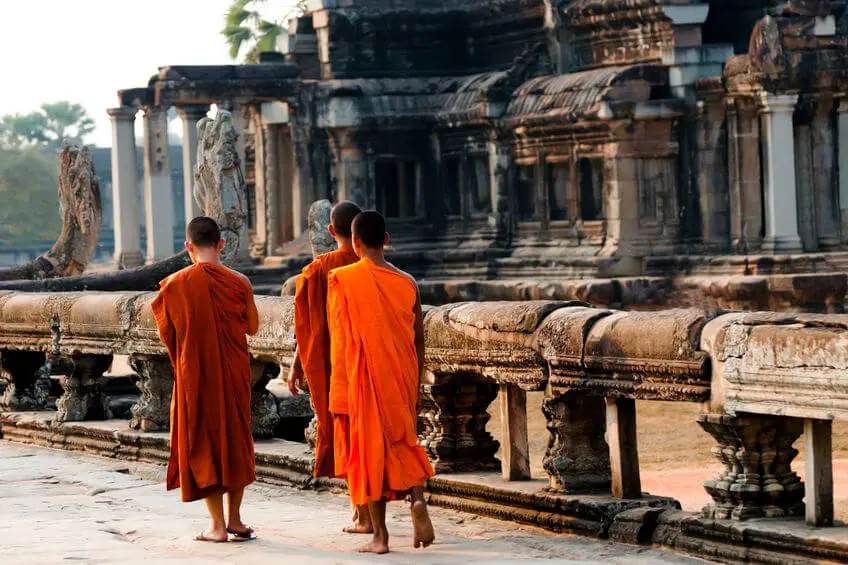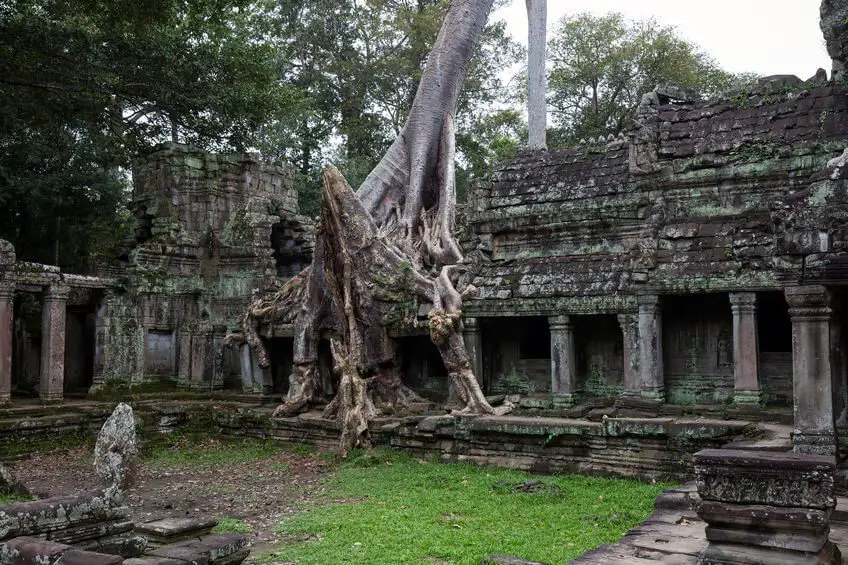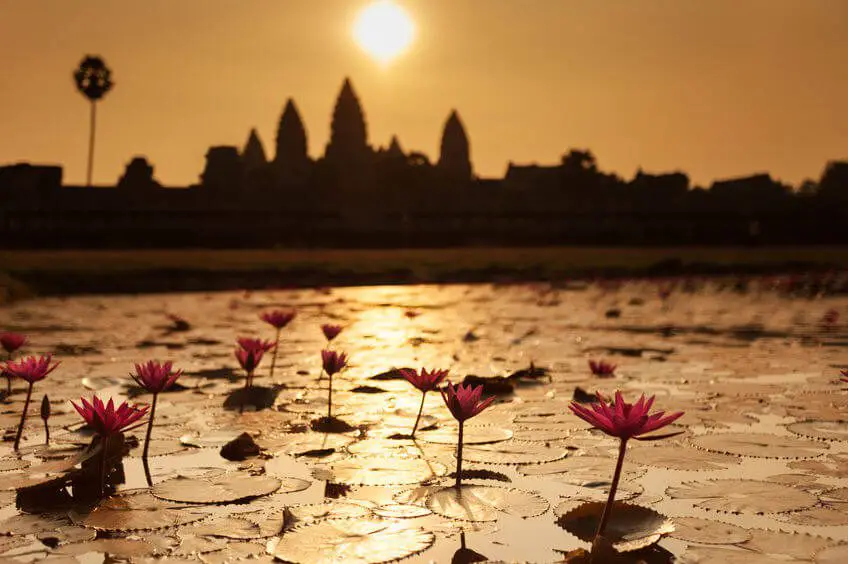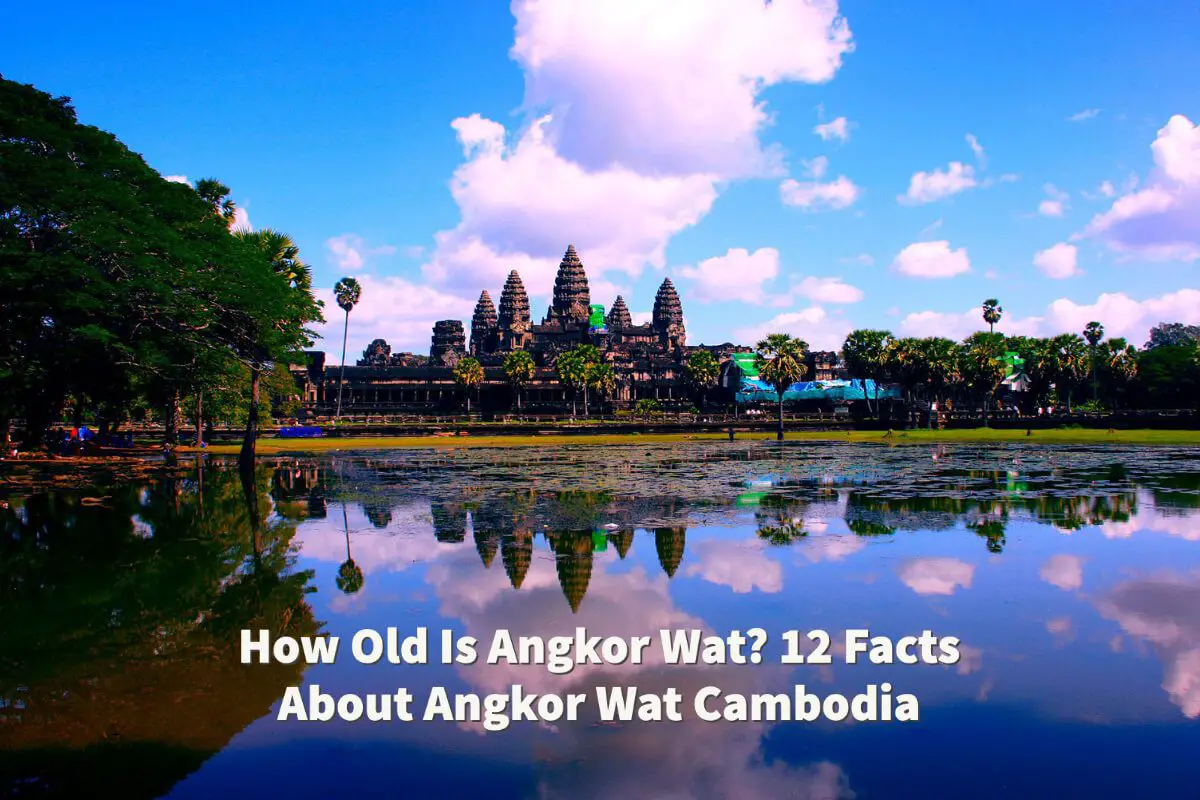One of the most amazing places to travel in Cambodia is Angkor Wat. Angkor Wat is located in Siem Reap and is a fascinating place to travel to.
Angkor Wat was founded in the 12th century by the Khmer Empire; the Angkor Wat complex is over 1,000 years old. Even though the complex is over 1,000 years old for many years, the world did not know it existed as it was buried in the dense Cambodian jungles. Traveling to Angkor Wat, you are amazed by its antiquity, beauty, and majesty. There are so many interesting facts about the temple complex.
Table of Contents
- How Old Is Angkor Wat?
- 12 Facts About Angkor Wat Cambodia
- 1 – Angkor Wat Was Built in the 12th Century
- 2 – Angkor Wat Was Built As A Hindu Temple
- 3. – Angkor Wat Was Hidden for Thousands of Years
- 4. – Angkor Wat Means Temple Capital city
- 5. – Angkor Wat Was the Center Of Southeast Asia
- 6. – Angkor Wat is a Khmer Architectural Masterpiece
- 7. – Angkor Wat Is The Name Of The Largest Temple
- 8. – 72 Temples In The Angkor Wat Area
- 9. – Angkor Wat Faces West
- 10. – Angkor Wat Offers Magnificent Sunrise and Sunsets
- 11. – Angkor Wat Has Elaborate Art
- 12.- Angkor Wat Has A Relief of Emperor Suryavarman II
- Listen To Our Podcast About Discovering the Ancient Marvel: Astonishing Facts About Angkor Wat Cambodia Below or By clicking here.
- Related Questions

How Old Is Angkor Wat?
The Khmer (Cambodian) Emperor Suryavarman II built Angkor Wat in the 12th Century; the Angkor Wat area was the Khmer Empire’s capital, now present-day Cambodia.
Angkor Wat was initially constructed as a personal mausoleum for Emperor Suryavarman II. It was a Hindu temple that was dedicated to the Hindu God Vishnu.
Many people may be surprised at how old Angkor Wat is. However, the Khmer Empire was a compelling period in Cambodian history. During the time of Angkor Wat, the Khmer Empire stretched from the Yunnan Province in Southern China to Vietnam to present-day Myanmar.
To understand how powerful the Khmer Empire was, you only need to visit present-day Angkor Wat in Cambodia to see the majesty of this temple; the Khmer Empire had so much wealth and power that they could build impressive structures like Angkor Wat.
The Angkor area and Angkor empire’s power peak was during the 11th to 13th centuries; at this time, Angkor Wat was one of the world’s largest urban centers. Countries from all over Asia would flock to Angkor.
12 Facts About Angkor Wat Cambodia
Angkor Wat is well-known and celebrated as a Cambodian World Heritage Site, but there’s much more to it than its impressive beauty! This vast ancient site remains in mystery, from the complex network of canals and bridges that encircle the entire temple area to the unique architecture.
If you’re planning to visit this region in Southeast Asia or are simply curious about Angkor Wat, Cambodia, read on for 12 fascinating facts about one of humanity’s most awe-inspiring expressions of faith and devotion.
Here are 12 of my favorite facts about Angkor Wat.
1 – Angkor Wat Was Built in the 12th Century
Angkor Wat was built for Emperor Suryavarman II, the Khmer King, from 1113 AD to about 1145 -1150 AD. Emperor Suryavarman II was the builder and architect of the Angkor Wat Temple.
Emperor Suryavarman II is considered a brilliant emperor. Emperor Suryavarman II had a strong military force, organized government, and major architectural projects such as Angkor Wat during his reign. He is thought by many historians to be one of the most significant Khmer Emperors ever to live.
2 – Angkor Wat Was Built As A Hindu Temple
Emperor Suryavarman II, the architect and mastermind of Angkor Wat, was also a practicing Hindu; he built the Angkor Wat Temple as a dedication to the Hindu god Vishnu.
Why Suryavarman II dedicated the Angkor Wat Temple to the Hindu god Vishu, we do not know. Most of the previous rulers of Cambodia focused their Hinduism on the Hindu god Shiva.
It seems that Emperor Suryavarman II loved the Hindu god Vishnu so much that when e died, he was posthumously given the name “Paramavishnuloka,” which means “He Who Entered The Heavenly World of Vishnu.

3. – Angkor Wat Was Hidden for Thousands of Years
The Angkor Wat temples are spread over 400 acres, which makes it the largest religious monument globally; despite how large the complex is, the temples were hidden in the jungles of Cambodia for thousands of years.
The Angkor Wat area was active in the 12th and 13th centuries; eventually, the temples were grown over by jungles and largely hidden from the rest of the world. Henri Mouhot, a French explorer, is credited with rediscovering the temple complexes in the 1840s.
Today, you can see some of the temples as Henri Mouhot found – grown over with the jungle coming out of the massive temple structures.
4. – Angkor Wat Means Temple Capital city
In the Khmer language, the name Angkor Wat means “temple capital city.” Angkor means “capital city,” and Wat means “temple.” So literally, the name Angkor Wat meant the ” temple capital city” or simply “temple city.”
The Angkor Wat “temple city” was built as a state temple and city complex that was the commerce and political center of the Khmer Empire. Hence, the area was a city, but in the heart of Angkor Wat city was the Angkor Wat temple.
5. – Angkor Wat Was the Center Of Southeast Asia
During the time of Angkor Wat, the area was the center of Southeast Asia. Emperor Suryavarman II was known to be a great diplomat. He established formal diplomatic relations with China as early as 1116 AD. This led to increased trade and commerce with China.
Emperor Suryavarman II also spent much time and effort forcing military action with Champa (present-day Vietnam). Most of this military action was not successful. There was a short period between 1145 and 1150 where there was some success, but it did not last long. Historians are unsure if King Suryavarman II died in one of those battles with Champa.
6. – Angkor Wat is a Khmer Architectural Masterpiece
Angkor Wat is a masterpiece of Khmer architecture, art, and culture. As the architect, this also means that Emperor Suryavarman II was also an architectural genius,
In 1992, the Angkor area became a UNESCO World Heritage site; Angkor Wat is also considered the world’s eighth wonder.
7. – Angkor Wat Is The Name Of The Largest Temple
The Angkor Wat Temple is the largest and most famous in the Angkor Wat complex; the Angkor Wat area is named after this.
As the Angkor Wat temples were designed and built for immortal gods, the architects only used the finest and most long-lasting materials they could find.
8. – 72 Temples In The Angkor Wat Area
There are 72 major temples in the Angkor Wat area; this does not include the hundreds of minor temples scattered throughout the area. You could spend weeks looking at every temple complex.
9. – Angkor Wat Faces West
The Angkor Wat temple faces west, the direction the Hindu god Vishnu is associated with. This is interesting as most Khmer temples face east.

10. – Angkor Wat Offers Magnificent Sunrise and Sunsets
One of the most popular things to do on a visit to Angkor Wat is to visit it for a magnificent sunrise and sunset. It truly does not get much better than some sunrises and sunsets you see over the Angkor Wat temple complexes. You can climb a small hill and watch the sunset over the magnificent temple ruins.
11. – Angkor Wat Has Elaborate Art
The Angkor Wat temple has over 1,860 carved apsaras and hundreds of meters of bas-reliefs depicting Hindu legends and scenes from contemporary life. The temple structures have some amazing art and carvings that you can not see anywhere else.
12.- Angkor Wat Has A Relief of Emperor Suryavarman II
There is a bas relief of Suryavarman II. He is the first Khmer Emperor to be depicted in art, and it shows how skilled the Angkor Wat artisans were during the 12th century.
This basrelief of Suryavarman II is on the south gallery of Angkor Wats walls and shows him seated. This is interesting as it gives us insight into the Emperor and his appearance.
I have been to Angkor Wat in Cambodia many times. It is a magnificent architectural structure that is worth visiting. Because of its majesty, it is considered the world’s eighth wonder.
Listen To Our Podcast About
Discovering the Ancient Marvel: Astonishing Facts About Angkor Wat Cambodia
Below or By clicking here.

At A Bus On A Dusty Road, we talk about travel, life, and ex-pat living. We are all about “Living Life As A Global Citizen.” We explore social, cultural, and economic issues and travel.
We would love to have you be part of our community. Sign up for our newsletter to keep up-to-date by clicking here. If you have any questions, you can contact me, Anita, by clicking here.
Listen to our Podcast called Dusty Roads. You can find it on all major podcast platforms. Try out listening to one of our podcasts by clicking here.
Subscribe to our A Bus On A Dusty Road YouTube Channel filled with great videos and information by clicking here.
Related Questions
Why Every Cyclist Should Ride Around Angkor Wat Cambodia?
Cycling around the Angkor Was Temple complexes is a great way to see some amazing ancient Cambodian temples. When you cycle around Angkor Wat, you will have the freedom to see Angkor Wat at your own pace and see things that you could never see in a car, bus, or even a tuk-tuk. Every cyclist should have cycled around Angkor Way on their bucket list.
You can discover more by reading our blog Why Every Cyclist Should Ride Around Angkor Wat Cambodia? by clicking here.
What Was The Main Religion in Cambodia Before Buddhism?
Before Buddhism was so prevalent in Cambodia, the main religion was Hinduism. In fact, Hinduism was the state religion of Cambodia for over 1000 years. The Angkor Wat temple complex in Siem Reap, Cambodia, was originally built as a Hindu temple.
You can learn more by reading What Was The Main Religion in Cambodia Before Buddhism? by clicking here.



3 responses to “How Old Is Angkor Wat? 12 Facts About Angkor Wat Cambodia”
Cool. I spent a long time looking for relevant content and found that your article gave me new ideas, which is very helpful for my research. I think my thesis can be completed more smoothly. Thank you.
Your article gave me a lot of inspiration, I hope you can explain your point of view in more detail, because I have some doubts, thank you.
Thank you very much for sharing, I learned a lot from your article. Very cool. Thanks. nimabi